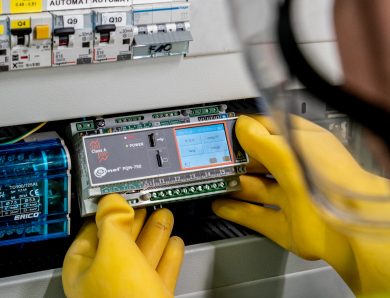
Reactive power compensation
The power quality primarily defines voltage changes and fluctuations, voltage unbalance and voltage harmonic distortions. The size and nature of reactive power also have a great influence on the power quality. The low level of the tg (φ) coefficient and keeping it within a narrow range of 0…0.4 has a positive effect on the increase in the efficiency of the use of power cables and transformers and on the improvement of the basic quality parameters.
Description of the identified problem
On an object with a very typical and even load in a weekly cycle, the excess tg (φ) was found in the energy billing. A representative section of the load levels was recorded and on this basis it is essential to estimate the necessary compensating power to obtain the value of tan (φ) below 0.4. Compensator work should also be considered.
Measuring equipment used
- PQM-702 Power Quality Analyzer (successor product Sonel PQM-710)
- Sonel F-1A flexible current probes
- Sonel Analysis software

Fig. 1. Picture of active power and tan (φ) of a representative load period

Fig. 2. Picture of active and reactive power of a representative load period
Remember that the behavior of the tg (φ) coefficient in combination with changes in active power and changes in reactive power of the 50 Hz component (Fig. 1) is significant. On this basis, it is possible to determine the value of the capacitive reactive power compensating the inductive component in order to obtain the expected value of tan (φ). The formulas (1), (2) apply in the calculations:

where:
tgR – actual value of the factor,
tgZ – set value of the factor,
QR – value of the fundamental component of reactive power,
QK – compensating reactive power value,
PR – value of the fundamental active power.
Initial conclusions
- The analysis is based on the scaled Fig. 2 and formulas (1) and (2).
- There is a clear correlation of active power and reactive power both in time and in terms of value, allowing the use of a fixed compensator.
- The active power level takes an average of two values: 67 kW (See 3.) and 75 kW (See 2.).
- The corresponding tg (φ) values are 0.62 and 0.85 Formula (2).
- Both values significantly exceed the value of 0.4.
- Using a capacitor bank with a capacity of 26.25 kVAr and permanently switched on, a tg (φ) of around 0.4 will be obtained.
- Using a capacitor bank with a capacity of 30 kVAr permanently switched on, a tg (φ) of around 0.35 will be obtained.
- Using a 41 kVAr capacitor bank permanently switched on, will cause a tg (φ) around 0 value, which poses a risk of overcompensation of the network.
- The most optimal value of the capacitor power is 30 kVAr.

Fig. 3. The image of phase-to-phase voltages in a representative load period

Fig. 4. The THD image of phase-to-phase voltages in a representative load period
Conclusions
- In the analyzed case of a representative observation, the reactive power level was always inductive with two dominant active power levels.
- The value of the compensating power of 30 kVAr determined from the formula (2) will reduce the tg (φ) factor to the level of approx. 0.35.
- After permanently installing a capacitive reactive load of this value, the tg (φ) factor should not fall below approx. 0.2.
- The slight variation of the supply voltage between 512 V and 524 V (Fig. 3) means a slight dispersion of the calculation results at the level of approx. 5%.
- A low THD U level indicates a low harmonic hazard in the voltage (Fig. 4.).
Recommendations
The low level of harmonics in the voltage indicates the possibility of using capacitors without reactors.
Author: Krzysztof Lorek, Sonel S.A.
Products mentioned in the article:






No Comment